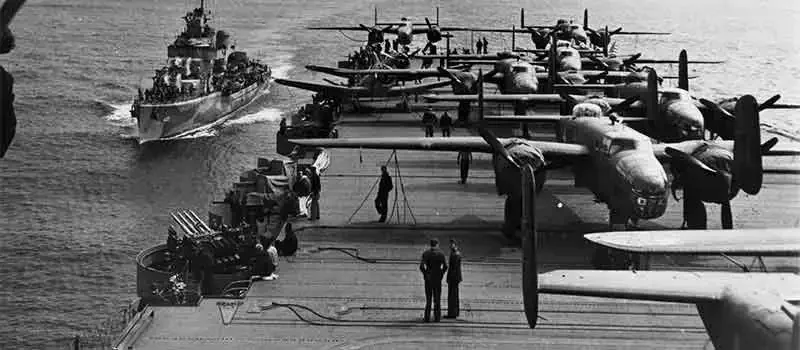- Military History
- Conflicts & Wars
- World War II Pacific Theater
- Doolittle Raid (Tokyo Raid) - April 1942

Doolittle Raid (Tokyo Raid) - April 1942 The surprising and daring raid on military targets at Tokyo, Yokohama, Yokosuka, Nagoya, and Kobe
On the 18th of April 1942, 16 American medium bombers commanded by Colonel James Harold Doolittle took off from the aircraft carrier USS Hornet to bomb Tokyo. The Doolittle Raid (Tokyo Raid) was a great success in propaganda terms, but eight of the pilots fell into Japanese hands.
The B-25 Mitchell twin-engine bombers used for the raid weighed 13 tons fully loaded and nothing so heavy had ever taken off from an aircraft-carrier before. Lengthy preparations were therefore necessary. On April 13, the aircraft-carrier Hornet, with these B-25's on board, rendezvoused with Task Force 16, under Halsey, which was to escort her. The plan was that Doolittle and his companions were to take off some 500 miles (805 km) from Japan, carry out their mission and land in Nationalist China as deck landings by B-25's were impossible.
Some 200 miles (320 km) east of the area from which the planes were to take off, Halsey's force fell in with an enemy patrol and the American admiral had to order Doolittle to take off at once as the secrecy could no longer be guaranteed. A few tons of bombs were shared out between the Japanese capital and the large cities of Nagoya and Kobe from 1300 hours on April 13, and no appreciable damage was done.
But, nonetheless, the psychological impact of Doolittle's raiders on the Japanese people and on the Japanese armed forces was immense. The Emperor's own palace had been exposed to the danger of a direct attack. The Imperial Armed Forces' loss of face had to be made good.
Of the 16 twin-engine B-25s which took part in the raid, one landed on the aerodrome at Vladivostok and was seized by the Soviet authorities. The pilots of the remaining 15, running out of fuel, either crash landed or ordered their crews to bail out. Of the 80 crew, five were interned by the Russians, 62 were picked up by the Chinese, one was killed while descending by parachute, four drowned, and eight were taken prisoner by the Japanese.
Given the shock that the raid caused in Japan, it is not surprising that the airmen were harshly treated from the beginning. Beaten and denied medical attention and sufficient rations, they were also bullied into signing confessions stating that they had intentionally bombed hospitals and civilian homes or strafed school children.

On the 18th of April 1942, airmen of the US Army Air Force, led by Lt. Col. James H. (Jimmy) Doolittle, carried the Battle of the Pacific to the heart of the Japanese empire with a surprising and daring raid on military targets at Tokyo, Yokohama, Yokosuka, Nagoya, and Kobe. This daring surprise attack against major cities resulted from coordination between the Army Air Force and the US Navy, which carried the sixteen North American B-25 medium bombers aboard the carrier U.S.S. Hornet to within take-off distance of the Japanese Islands. Here, a pair of alert escorts follow the U.S.S. Hornet to protect her lethal cargo of B-25 bombers. (U.S. Air Force Photo)
The Japanese leadership was split on whether the airmen should be treated as prisoners of war or war criminals. The Chief of the General Staff considered them to be war criminals and demanded their execution, but Prime Minister Hideki Tojo was reluctant to accede, instead ordering the authorities to pass a statute, allowing Japan to impose the death penalty on captured aviators. This measure, he believed, would be a sufficient deterrent against future raids.
However, under pressure from the military, Tojo eventually relented; there would be a show trial in Shanghai, after which the airmen would be executed. On the 28th of August 1942, in a trial that included no defense counsel, no interpreters, and no witnesses, death penalties were handed down to all eight men. However, Tojo, still uncomfortable with the sentences, appealed to Emperor Hirohito, who commuted five of the sentences to life in prison. The other three, whose "confessions" included admissions that they had attacked school children, would still face the death penalty.
On the 15th of October 1942, Lieutenants Dean E. Hallmark and William G. Farrow and Sergeant Harold A. Spatz were executed by firing squad. Lieutenant Robert J. Meder died in solitary confinement in December 1943. Lieutenants Chase J. Nielsen, Robert L. Hite, George Barr and Corporal Jacob DeShazer survived over three years in solitary confinement to be liberated in August 1945.
In 1946, four former Japanese soldiers were tried for their part in the executions of Hallmark, Farrow, and Spatz. They found all guilty, but the light sentences handed down ranging from five to nine years in prison outraged many Americans.
- Japan
- United States
- WWII (1939-1945)
- Pacific War (1941-1945)
- {{#owner}}
- {{#url}} {{#avatarSrc}}
{{name}} {{/url}} {{^url}} {{#avatar}} {{& avatar}} {{/avatar}} {{name}} {{/url}} - {{/owner}} {{#created}}
- {{created}} {{/created}}
























